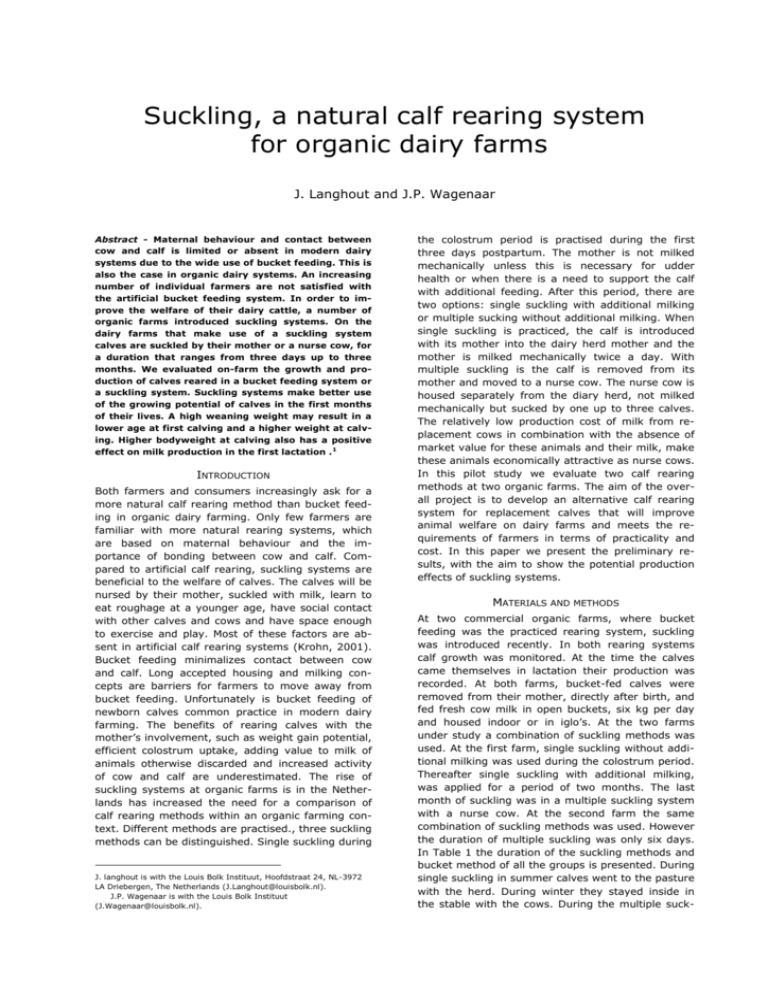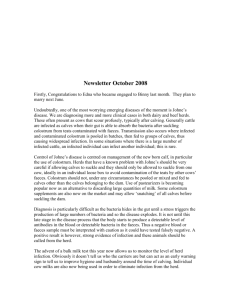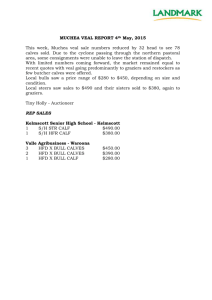Other
advertisement

Suckling, a natural calf rearing system for organic dairy farms J. Langhout and J.P. Wagenaar Abstract - Maternal behaviour and contact between cow and calf is limited or absent in modern dairy systems due to the wide use of bucket feeding. This is also the case in organic dairy systems. An increasing number of individual farmers are not satisfied with the artificial bucket feeding system. In order to improve the welfare of their dairy cattle, a number of organic farms introduced suckling systems. On the dairy farms that make use of a suckling system calves are suckled by their mother or a nurse cow, for a duration that ranges from three days up to three months. We evaluated on-farm the growth and production of calves reared in a bucket feeding system or a suckling system. Suckling systems make better use of the growing potential of calves in the first months of their lives. A high weaning weight may result in a lower age at first calving and a higher weight at calving. Higher bodyweight at calving also has a positive effect on milk production in the first lactation . 1 INTRODUCTION Both farmers and consumers increasingly ask for a more natural calf rearing method than bucket feeding in organic dairy farming. Only few farmers are familiar with more natural rearing systems, which are based on maternal behaviour and the importance of bonding between cow and calf. Compared to artificial calf rearing, suckling systems are beneficial to the welfare of calves. The calves will be nursed by their mother, suckled with milk, learn to eat roughage at a younger age, have social contact with other calves and cows and have space enough to exercise and play. Most of these factors are absent in artificial calf rearing systems (Krohn, 2001). Bucket feeding minimalizes contact between cow and calf. Long accepted housing and milking concepts are barriers for farmers to move away from bucket feeding. Unfortunately is bucket feeding of newborn calves common practice in modern dairy farming. The benefits of rearing calves with the mother’s involvement, such as weight gain potential, efficient colostrum uptake, adding value to milk of animals otherwise discarded and increased activity of cow and calf are underestimated. The rise of suckling systems at organic farms is in the Netherlands has increased the need for a comparison of calf rearing methods within an organic farming context. Different methods are practised., three suckling methods can be distinguished. Single suckling during J. langhout is with the Louis Bolk Instituut, Hoofdstraat 24, NL-3972 LA Driebergen, The Netherlands (J.Langhout@louisbolk.nl). J.P. Wagenaar is with the Louis Bolk Instituut (J.Wagenaar@louisbolk.nl). the colostrum period is practised during the first three days postpartum. The mother is not milked mechanically unless this is necessary for udder health or when there is a need to support the calf with additional feeding. After this period, there are two options: single suckling with additional milking or multiple sucking without additional milking. When single suckling is practiced, the calf is introduced with its mother into the dairy herd mother and the mother is milked mechanically twice a day. With multiple suckling is the calf is removed from its mother and moved to a nurse cow. The nurse cow is housed separately from the diary herd, not milked mechanically but sucked by one up to three calves. The relatively low production cost of milk from replacement cows in combination with the absence of market value for these animals and their milk, make these animals economically attractive as nurse cows. In this pilot study we evaluate two calf rearing methods at two organic farms. The aim of the overall project is to develop an alternative calf rearing system for replacement calves that will improve animal welfare on dairy farms and meets the requirements of farmers in terms of practicality and cost. In this paper we present the preliminary results, with the aim to show the potential production effects of suckling systems. MATERIALS AND METHODS At two commercial organic farms, where bucket feeding was the practiced rearing system, suckling was introduced recently. In both rearing systems calf growth was monitored. At the time the calves came themselves in lactation their production was recorded. At both farms, bucket-fed calves were removed from their mother, directly after birth, and fed fresh cow milk in open buckets, six kg per day and housed indoor or in iglo’s. At the two farms under study a combination of suckling methods was used. At the first farm, single suckling without additional milking was used during the colostrum period. Thereafter single suckling with additional milking, was applied for a period of two months. The last month of suckling was in a multiple suckling system with a nurse cow. At the second farm the same combination of suckling methods was used. However the duration of multiple suckling was only six days. In Table 1 the duration of the suckling methods and bucket method of all the groups is presented. During single suckling in summer calves went to the pasture with the herd. During winter they stayed inside in the stable with the cows. During the multiple suck- ling period nurse cows were kept outdoors with the calves in summer and in de stable, separated by fences from the herd, during winter. Post weaning, bucket fed calves and suckling calves all received the same treatment. to introduce the suckling calves at an earlier age to the bull than the bucket fed calves. 600 Norm Lineair (Farm one suckling system) Table 1. Characteristics of two rearing methods for replacement calves, bucket feeding and suckling, at two organic dairy farms. Bucket n Single suckling (days) Multiple suckling Suckling Lineair (Farm one bucket feeding) Farm two Bucket Lineair (Farm two bucket feeding) Suckling 13 13 10 7 n.a. n.a. 60 28 n.a. n.a. 63 6 90 88 115 70 0 0 200 Age in days 400 600 Figure 1. Weight development of calves reared with a bucket feeding or suckling method at two dairy farms and the (days) Weaning age (days) Lineair (Farm two suckling system) 200 Farm one Group Weight in kg 400 norm for weight development of replacement calves at dairy farms in the Netherlands. n.a.: not applicable Comparing the measured production in the milking parlour, of both suckled and non-suckled cows, we found a difference of 10 kg of milk during the first 14 days of lactation. From 15 days up to 60 days a production difference of 15 kg milk was found. This difference is primarily caused by the milk consumption of the calf and secondarily by incidental problems with milk let down. During multiple suckling the consumption is limited to 5 to 10 kg per day because of production of the nurse cow and the number of calves suckling her. This has resulted in an younger age at calving. Table 2 show the production of the heifers in their first lactation. At farm two show the sucklin group a higher milk production at 305 days in lactation. At the time of writing the animals were still in their first lactation and therefore the total production is not presented. Table 2. Production of heifers reared with a bucket feeding or suckling method at two organic dairy farms. Farm one Group RESULTS Youth growth on milk seems relatively easy. Suckling calves show increased growth compared to bucket fed calves. The difference in weight develops in the first months. At farm two the mean growth of suckled calves pre weaning was 0.97 kg/day vs. 0.59 kg/day for bucket fed calves, the difference is 0.38 kg/day (P< 0.1). For the second month a difference of 0,5 kg per day was found (P< 0.001). In figure 1, body weight development of suckling and bucket fed calves of both farms are presented as linear trend lines. Figure 1 contains repeated measurements. The conventional norm for the live weight development of calves has also been depicted. This norm is higher compared to the realized weight gain of bucket fed calves at the farm. This is caused by the applied feeding regime, which implied low concentrate intake. The difference in weight development of suckling calves between the two farms can be explained by the duration of the suckling period. After weaning the increased growth levels out, nevertheless does the difference in live weight accomplished in the first months hold. From the age of 18 months partum affects the picture. After calves are weaned their ration largely exists of roughage, often of inferior quality, because the best quality roughage goes to producing animals. Moreover, because of the relative high cost of organic concentrate feed, calves receive a limited quantity. As a result sub-optimal feeding conditions might occur. The average age at calving of heifers at organic or extensive conventional farms is higher than on conventional farms. On this basis it is hard and costly to reduce the age at first calving. At farm one the development (weight) of calves was such that the farmer decided N Age at (days) day Suckling Bucket Suckling 13 13 10 7 calving (months) 305 Farm two Bucket production (kg milk) Days in milk 29 26 26 26 868 792 777 780 5449 4585 5963 6291 318 300 401 318 CONCLUSION Suckling systems make better use of the growing potential of calves in the first months of their lives. A high weaning weight may result in a lower age at first calving or in a higher weight at calving. Higher bodyweight at calving also has a positive effect on milk production in the first lactation. The feeding regime in suckling systems utilises youth growth on a ration of milk and is compatible with the feeding strategy at extensive conventional and organic farms. However, the biggest advantage of suckling systems may be the potential to improve welfare and naturalness in the production system by restoring maternal and social behaviour. REFERENCES Krohn, C.C., (2001). Applied animal Behaviour Science. 72: 271-280. ACKNOWLEDGEMENT This study was made possible by the cooperation of innovative farmers and funding by Provincie NoordHolland, Triodos Bank and supported by consumer donations.


